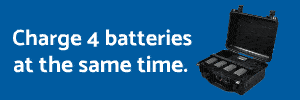- Joined
- Dec 15, 2019
- Messages
- 12
- Reaction score
- 1
I have a new Parrot Anafi. Looked at several YouTubes on (fast) battery chargers. What is best for the life of the batteries? I am not smart enough to determine the answer. Seems there are three ways to charge. Below are models on Amazon for your reference. It seems balancing while charging is a factor. Three charging types are:
1) USB-C connection with Type A on power end. I have mine plugged into my Samsung wall puppy with 2 USB-A connections. Output: DC5V – 2.1A
2) A Cradle type device charging 3 Anafi batteries at once, supposedly simultaneously. Samples found at:
Anbee Multifunctional Battery Charger Hub. Amazon.com: Anbee Multifunctional Battery Charger Hub Compatible with Parrot Anafi Drone, Home Charger & Car Charger 2-in-1: Toys & Games $37.99
Hanatora Battery Charger. Amazon.com: Hanatora Battery Charger (Indoor and in-car) for Parrot Anafi/ANAFI Base/ANAFI Extended/ANAFI FPV/ANAFI Thermal/ANAFI Work,Multi-Function Charging Accessories: Toys & Games $37.99
3) A multi USB device with multiple USB ports. Samples found at:
Hanatora Home and Carge Charge. 6 port. Amazon.com: Hanatora Home and Car Battery Charger 6 Port for Parrot Anafi/Anafi Base/Extended/Anafi FPV/ANAFI Thermal/Work and Skycontroller 3,USB Quick Charge 3.0,4 Batteries Charging Station: Toys & Games $36.99
AmazonBasics 5-port. https://amzn.to/2sq0V5g $29.99
Thanks!!
1) USB-C connection with Type A on power end. I have mine plugged into my Samsung wall puppy with 2 USB-A connections. Output: DC5V – 2.1A
2) A Cradle type device charging 3 Anafi batteries at once, supposedly simultaneously. Samples found at:
Anbee Multifunctional Battery Charger Hub. Amazon.com: Anbee Multifunctional Battery Charger Hub Compatible with Parrot Anafi Drone, Home Charger & Car Charger 2-in-1: Toys & Games $37.99
Hanatora Battery Charger. Amazon.com: Hanatora Battery Charger (Indoor and in-car) for Parrot Anafi/ANAFI Base/ANAFI Extended/ANAFI FPV/ANAFI Thermal/ANAFI Work,Multi-Function Charging Accessories: Toys & Games $37.99
3) A multi USB device with multiple USB ports. Samples found at:
Hanatora Home and Carge Charge. 6 port. Amazon.com: Hanatora Home and Car Battery Charger 6 Port for Parrot Anafi/Anafi Base/Extended/Anafi FPV/ANAFI Thermal/Work and Skycontroller 3,USB Quick Charge 3.0,4 Batteries Charging Station: Toys & Games $36.99
AmazonBasics 5-port. https://amzn.to/2sq0V5g $29.99
Thanks!!




